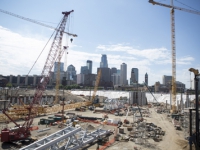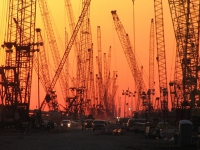Construction employment stalls in June; raw materials prices slip but product prices riseEditor’s note: Construction Citizen is proud to partner with AGC America to bring you AGC Chief Economist Ken Simonson's Data DIGest. Check back each week to get Ken's expert analysis of what's happening in our industry.Nonfarm payroll employment increased by 223,000 in June, seasonally adjusted, and by 2,935,000 (2.1%) over 12 months, the Bureau of Labor Statistics (BLS) reported on July 2. Construction employment was flat for the month and rose by 259,000 (4.2%) from a year ago to 6,380,000. Residential construction employment (residential building and specialty trade contractors) slipped by 2,400 for the month but increased by 127,000 (5.5%) over 12 months. Nonresidential employment (building, specialty trades, and heavy and civil engineering construction) increased by 2,700 and 131,800 (3.5%), respectively.
Construction spending hits 6-1/2 year high in May; metro job gains shrink; ABI moves upEditor’s note: Construction Citizen is proud to partner with AGC America to bring you AGC Chief Economist Ken Simonson's Data DIGest. Check back each week to get Ken's expert analysis of what's happening in our industry.Construction spending in May totaled $1.036 trillion at a seasonally adjusted annual rate, the highest rate since October 2008, the Census Bureau reported today. The level was up 0.8% from the rate in April (which was revised up by a steep 2% or $20 billion) and up 8.2% from May 2014. Private nonresidential spending increased 1.5% for the month and 13% year-over-year, private residential spending rose 0.3% and 7.8%, respectively, and public construction spending gained 0.7% and 2.8%. However, the residential total masks a 13% year-over-year rise in new construction (21% for multifamily and 11% for single-family) and a drop of 3.4% in improvements. A 70% increase in manufacturing construction (led by a doubling of spending for chemical plants and tripling for transportation equipment plants) made this the largest private nonresidential segment. Next came power construction (conventional and renewable power plus oil and gas fields and pipelines), down 22% year-over-year, followed by commercial (new and renovated retail, warehouse and farm), up 11%; and office, up 27%. The two top public segments also had year-over-year gains: highway and street construction, 1.7%; and public educational spending, 3.4%. Census made annual revisions to 2013 and 2014 data. Total spending rose 6.6% in 2013 (instead of 5.6%) and 4.8% in 2014 (instead of 5.5%).
July 06, 2015
Forty states add jobs in May; job openings outpace hires; nonres, housing starts pick upEditor’s note: Construction Citizen is proud to partner with AGC America to bring you AGC Chief Economist Ken Simonson's Data DIGest. Check back each week to get Ken's expert analysis of what's happening in our industry.Seasonally adjusted construction employment rose in 40 states and the District of Columbia from May 2014 to May 2015 and declined in 10 states, an AGC analysis of Bureau of Labor Statistics (BLS) data released on Friday showed. California again added the most construction jobs (46,600 jobs, 6.9%), followed by Florida (28,200, 7.2%), Texas (20,300, 3.1%), Washington (18,100, 11.6%) and North Carolina (15,600, 8.8%).
June 23, 2015
PPI rises in May; April job openings widen; Manpower survey shows steady hiring plansEditor’s note: Construction Citizen is proud to partner with AGC America to bring you AGC Chief Economist Ken Simonson's Data DIGest. Check back each week to get Ken's expert analysis of what's happening in our industry.The producer price index (PPI) for final demand increased 0.3%, not seasonally adjusted (0.5%, seasonally adjusted), in May but declined 1.1% over 12 months, the Bureau of Labor Statistics (BLS) reported today. AGC posted an explanation and tables focusing on construction prices and costs. Final demand includes goods, services and five types of nonresidential buildings that BLS says make up 34% of total construction. The PPI for final demand construction, not seasonally adjusted, rose 0.3% in May and 2.0% over 12 months. The overall PPI for new nonresidential building construction—a measure of the price that contractors say they would charge to build a fixed set of five categories of buildings—climbed 1.8% since May 2014. The 12-month increases ranged from 0.9% for healthcare construction to 1.4% for warehouses, 1.8% for schools and industrial buildings, and 2.2% for offices.
June 15, 2015
May construction employment, April spending hit 6-year highs; most metros add jobsEditor’s note: Construction Citizen is proud to partner with AGC America to bring you AGC Chief Economist Ken Simonson's Data DIGest. Check back each week to get Ken's expert analysis of what's happening in our industry.Nonfarm payroll employment increased by 280,000 in May, seasonally adjusted, and by 3,058,000 (2.2%) over 12 months, the Bureau of Labor Statistics (BLS) reported on Friday. Construction employment rose by 17,000 and 273,000 (4.5%), respectively, to 6,387,000, the highest level since February 2009. Residential construction employment (residential building and specialty trade contractors) climbed by 8,500 for the month and 149,000 (6.5%) over 12 months. Nonresidential employment (building, specialty trades, and heavy and civil engineering construction) increased by 8,600 and 124,300 (3.3%), respectively. Average hourly earnings of all employees in construction rose to $27.34, a gain of 2.7% over the past year, up from 2.3% in the previous 12 months and 1.3% from May 2012 to May 2013.
June 08, 2015
Construction jobs increase in 40 states in April; materials, labor costs dip, IHS findsEditor’s note: Construction Citizen is proud to partner with AGC America to bring you AGC Chief Economist Ken Simonson's Data DIGest. Check back each week to get Ken's expert analysis of what's happening in our industry.Seasonally adjusted construction employment rose in 40 states and the District of Columbia from April 2014 to April 2015, declined in seven and remained level in Indiana, Oregon and Vermont, an AGC analysis of Bureau of Labor Statistics (BLS) data released on Wednesday showed. California again added the most construction jobs (42,600 jobs, 6.4%), followed by Florida (32,200, 8.2%), Texas (25,300, 3.9%), Washington (18,700, 12.0%) and Michigan (14,800, 10.6%). Idaho again added the highest percentage of new construction jobs (12.4%, 4,400), followed by Washington and Michigan. The largest and steepest percentage losses again occurred in West Virginia (-4,400, -13.1%) and Mississippi (-3,200, -6.3%). U.S. construction employment rose 4.6% over the period, BLS reported on May 8. Despite the strong, widespread gains, only five states have topped pre-recession highs for construction employment:
May 29, 2015
Dodge, Census report rebound in April starts, but ABI slips; hotel outlook stays rosyEditor’s note: Construction Citizen is proud to partner with AGC America to bring you AGC Chief Economist Ken Simonson's Data DIGest. Check back each week to get Ken's expert analysis of what's happening in our industry.The value of new construction starts increased 10% from March to April at a seasonally adjusted annual rate, Dodge Data & Analytics (formerly McGraw Hill Construction) reported on Thursday, based on data it collected. "The nonresidential building sector came in particularly strong [up 58% from March], lifted by the inclusion of two massive projects as April starts—an $8.1 billion petrochemical plant in Louisiana and a $1.2 billion office/retail high-rise in New York [City]. Meanwhile, residential building slipped [-3%] in April, and nonbuilding construction lost momentum [-17%] as the result of a pullback by public works.
May 25, 2015
PPI falls overall, edges up for construction; automakers announce new plantsEditor’s note: Construction Citizen is proud to partner with AGC America to bring you AGC Chief Economist Ken Simonson's Data DIGest. Check back each week to get Ken's expert analysis of what's happening in our industry.The producer price index (PPI) for final demand decreased 0.3%, not seasonally adjusted (-0.4%, seasonally adjusted), in April and 1.3% over 12 months, the Bureau of Labor Statistics (BLS) reported on Thursday. AGC posted an explanation and tables focusing on construction prices and costs. Final demand includes goods, services and five types of nonresidential buildings that BLS says make up 34% of total construction.
May 18, 2015
Construction hiring rebounds in April; starts slip, CMD says; planning rises, Dodge saysEditor’s note: Construction Citizen is proud to partner with AGC America to bring you AGC Chief Economist Ken Simonson's Data DIGest. Check back each week to get Ken's expert analysis of what's happening in our industry.Nonfarm payroll employment increased by 223,000 in April, seasonally adjusted, and by 2,982,000 (2.2%) over 12 months, the Bureau of Labor Statistics (BLS) reported on Friday. Construction employment posted its strongest monthly increase since January 2014, rising by 45,000, following a drop of 9,000 in March. Since April 2014 construction employment increased by 280,000 (4.6%) to 6,383,000, the highest level since March 2009. Nevertheless, the April total was 1,343,000 (17%) below the record set nine years before.
May 13, 2015
Construction spending slips in March; jobs grow in 70% of metros; wages accelerateEditor’s note: Construction Citizen is proud to partner with AGC America to bring you AGC Chief Economist Ken Simonson's Data DIGest. Check back each week to get Ken's expert analysis of what's happening in our industry.Construction spending in March totaled $967 billion at a seasonally adjusted annual rate, down 0.6% from the upwardly revised rate in February, but up 2.0% from March 2014, the Census Bureau reported on Wednesday. Because unseasonably mild or severe weather can distort monthly comparisons in winter, it is more revealing to compare year-to-date figures for January through March combined. On that basis, total spending increased 3.2% from the same months of 2014, private residential spending edged up 0.8%, private nonresidential spending increased 6.4% and public construction spending gained 1.7%. The largest private nonresidential segment was "power" construction, which in Census' classification includes conventional and renewable power plus oil and gas fields and pipelines, and which plunged 16% year-to-date.
May 05, 2015






















